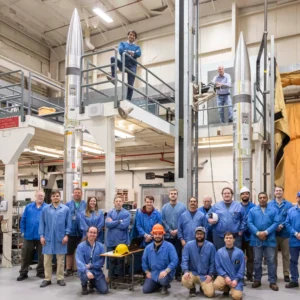This photo shows the three APEP sounding rockets and the support team after successful assembly. (Credit: APEP)
NASA is ready to launch three sounding rockets during the rare celestial event of a total solar eclipse on April 8, 2024.
The mission aims to shed light on how the Earth’s upper atmosphere reacts to the sudden and temporary absence of sunlight.
The Atmospheric Perturbations around Eclipse Path (APEP) mission will see its sounding rockets ascend from NASA’s Wallops Flight Facility in Virginia, targeting the ionosphere, a layer of Earth’s atmosphere that becomes notably disturbed when the Moon’s shadow eclipses the Sun.
This trio of rockets, which previously saw action during the annular solar eclipse in October 2023 at the White Sands Test Facility in New Mexico, has been refurbished with advanced instrumentation for their upcoming mission.
The project is spearheaded by Aroh Barjatya, Professor of Engineering Physics at Embry-Riddle Aeronautical University, Florida, and director of the Space and Atmospheric Instrumentation Lab.
The scheduled launch times for the sounding rockets are meticulously planned: one will ascend 45 minutes before the eclipse reaches its peak, another during the eclipse, and the final rocket will be launched 45 minutes after the peak.
This staggered launch sequence is crucial for capturing the dynamic changes in the ionosphere caused by the eclipse, changes that could potentially disrupt communication systems on Earth.
“It’s an electrified region that reflects and refracts radio signals, and also impacts satellite communications as the signals pass through,” said Barjatya. “Understanding the ionosphere and developing models to help us predict disturbances is crucial to making sure our increasingly communication-dependent world operates smoothly.”
This map details the path the Moon’s shadow will take as it crosses the contiguous U.S. during the annular solar eclipse on Oct. 14, 2023, and total solar eclipse on April 8, 2024. (Credit: NASA)
More from NASA:
The APEP rockets are expected to reach a maximum altitude of 260 miles (420 kilometers). Each rocket will measure charged and neutral particle density and surrounding electric and magnetic fields. “Each rocket will eject four secondary instruments the size of a two-liter soda bottle that also measure the same data points, so it’s similar to results from fifteen rockets, while only launching three,” explained Barjatya. Three secondary instruments on each rocket were built by Embry-Riddle, and the fourth one was built at Dartmouth College in New Hampshire.
In addition to the rockets, several teams across the U.S. will also be taking measurements of the ionosphere by various means. A team of students from Embry-Riddle will deploy a series of high-altitude balloons. Co-investigators from the Massachusetts Institute of Technology’s Haystack Observatory in Massachusetts, and the Air Force Research Laboratory in New Mexico, will operate a variety of ground-based radars taking measurements. Using this data, a team of scientists from Embry-Riddle and Johns Hopkins University Applied Physics Laboratory are refining existing models. Together, these various investigations will help provide the puzzle pieces needed to see the bigger picture of ionospheric dynamics.
When the APEP sounding rockets launched during the 2023 annular solar eclipse, scientists saw a sharp reduction in the density of charged particles as the annular eclipse shadow passed over the atmosphere. “We saw the perturbations capable of affecting radio communications in the second and third rockets, but not during the first rocket that was before peak local eclipse” said Barjatya. “We are super excited to relaunch them during the total eclipse, to see if the perturbations start at the same altitude and if their magnitude and scale remain the same.”
The next total solar eclipse over the contiguous U.S. is not until 2044, so these experiments are a rare opportunity for scientists to collect crucial data.
The mission’s name, APEP, is a nod to the mythological serpent that was believed to be Ra’s eternal adversary, symbolizing the eternal struggle between light and darkness, according to NASA.
The ancient Egyptians thought that during an eclipse, Apep came close to devouring the Sun deity, which is an allegory for the cosmic event.
Meanwhile, some U.S. states, including, Indiana, Texas, and New York have declared a state of emergency ahead of the eclipse.
The post NASA to Launch Three ‘Sounding Rockets’ During Total Solar Eclipse — Project Named After the Egyptian God of Darkness and Chaos appeared first on The Gateway Pundit.





